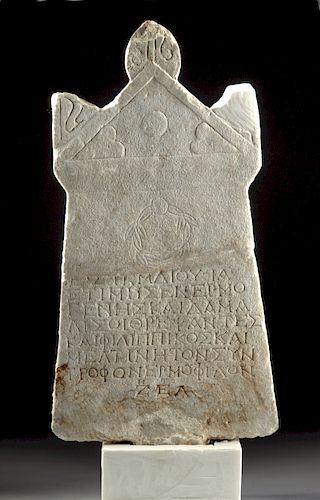Greek Stone Stele with Inscription - Naiskos Form
Lot 40c
About Seller
Artemis Fine Arts
686 S Taylor Ave, Ste 106
Louisville, CO 80027
United States
Selling antiquities, ancient and ethnographic art online since 1993, Artemis Gallery specializes in Classical Antiquities (Egyptian, Greek, Roman, Near Eastern), Asian, Pre-Columbian, African / Tribal / Oceanographic art. Our extensive inventory includes pottery, stone, metal, wood, glass and textil...Read more
Estimate:
$7,000 - $9,000
Absentee vs Live bid
Two ways to bid:
- Leave a max absentee bid and the platform will bid on your behalf up to your maximum bid during the live auction.
- Bid live during the auction and your bids will be submitted real-time to the auctioneer.
Bid Increments
| Price | Bid Increment |
|---|---|
| $0 | $25 |
| $300 | $50 |
| $1,000 | $100 |
| $2,000 | $250 |
| $5,000 | $500 |
| $10,000 | $1,000 |
| $20,000 | $2,500 |
| $50,000 | $5,000 |
| $100,000 | $10,000 |
| $200,000 | $20,000 |
About Auction
By Artemis Fine Arts
Sep 26, 2019
Set Reminder
2019-09-26 10:00:00
2019-09-26 10:00:00
America/New_York
Bidsquare
Bidsquare : Exceptional Day 1: Antiquities & Asian Art
https://www.bidsquare.com/auctions/artemis-gallery/exceptional-day-1-antiquities-asian-art-4437
Day 1 of an important 2-day auction featuring exceptional, museum-worthy examples of Egyptian, Greek, Etruscan, Roman, Viking, Russian, Near Eastern, as well as Asian Art from China, Japan, Thailand, Vietnam, Burma and India. Artemis Fine Arts info@artemisfinearts.com
Day 1 of an important 2-day auction featuring exceptional, museum-worthy examples of Egyptian, Greek, Etruscan, Roman, Viking, Russian, Near Eastern, as well as Asian Art from China, Japan, Thailand, Vietnam, Burma and India. Artemis Fine Arts info@artemisfinearts.com
- Lot Description
Ancient Greece, Hellenistic Period, ca. 3rd century BCE. A wonderful stone stele of a rectangular form that gently tapers at the upper end and is topped by a pediment. The main body of the stele is adorned by an olive or laurel wreath - a symbol of peace, triumph, and wisdom - above a Greek inscription, a decree to honor an elite individual named Hermophilos who lived to be 30 years old. (See translation below.) The pediment is inscribed with a triangle that contains a bas relief circle in the center and two opposing curvilinear forms at the lower corners that create what appear to be hearts to modern eyes. Each of the corners is topped with a decorative finial. A carved relief stele such as this one was part of a long tradition of marking the graves of elite and even some middle class Greek citizens. The form of this stele was intended to imitate a naiskos, a small temple/altar with a triangular pediment. Size: 14" W x 30.625" H (35.6 cm x 77.8 cm)
The inscription translates as follows: "In the eleventh year of Stemdios, Hermogenes and Damalis, his nurturers, and Philippikos and Meltine honored their companion Hermophilos. He lived thirty years." Please note that "Stemdios" was most likely the name of an important person, like a governor, whose time in office was used to mark dates (like the Athenian archons). Also, s??t??f?? is a bit stronger than "companion," implying that Philippikos and Meltine grew up with Hermophilos.
The British Museum has a similar example in their collection (museum number 1785,0527.7).
Provenance: private J.H. collection, Beaverton, Oregon, USA
All items legal to buy/sell under U.S. Statute covering cultural patrimony Code 2600, CHAPTER 14, and are guaranteed to be as described or your money back.
A Certificate of Authenticity will accompany all winning bids.
We ship worldwide and handle all shipping in-house for your convenience.
#149610Left proper finial of pediment restored. Losses to peripheries of central finial. Right proper finial reattached with restoration over break lines. The main body reassembled from two large pieces with break line between wreath and inscription. Normal surface wear commensurate with age. Some staining and deposits as shown. White marble base/stand in which the stele sits (can be removed) is a new addition.Condition
- Shipping Info
-
All shipping is handled in-house for your convenience. Your invoice from Artemis Gallery will include shipping calculation instructions. If in doubt, please inquire BEFORE bidding for estimated shipping costs for individual items.
-
- Buyer's Premium



 EUR
EUR CAD
CAD AUD
AUD GBP
GBP MXN
MXN HKD
HKD CNY
CNY MYR
MYR SEK
SEK SGD
SGD CHF
CHF THB
THB















